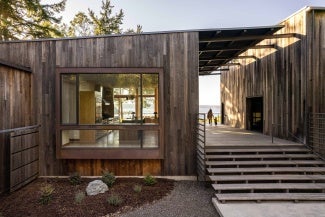
Study: How homeowners are spending remodeling design dollars
Data show a growing desire by homeowners to renovate and rejuvenate their homes. A study by AIA partner Marvin reveals some of the top design options they’re seeking.
Are we living in—or about to enter—the “golden age of renovation?” Many signs point to a resounding yes. Factors such as aging housing stock and volatile mortgage rates are driving an increased interest in improvement activities, while more homeowner-focused variables—including a growing desire for in-home technological advancements and increased emotional well-being through thoughtful design—play a role as well.
Below are highlights from a recent trends report exploring the transformation taking place all across the home renovation landscape.
First, let’s take a look at the data behind the trends
Homeowners are showing a growing desire to rejuvenate their physical spaces and stay in their existing homes. The numbers back that up.
• Home improvement spending has increased by more than $150 billion since 2019, according to the Harvard Joint Center for Housing Studies.
• A survey by Zillow indicates that homeowners with mortgage rates below 5% are almost twice as likely to remain in their current homes.
Simultaneously, the housing market is flooded with an influx of aging properties. Homes falling within the 20- to 39-year age range have reached what is considered “prime remodeling age,” a time when homeowners typically consider renovations.
• The number of homes falling into this age bracket is projected to peak at 24.2 million by 2027, according to the National Kitchen & Bath Association (NKBA), marking an almost 20% increase in just under a decade.
As the demand for remodeling grows with the aging housing stock, so do remodeling budgets.
• The 2023 U.S. Houzz & Home Study reveals that in 2022, the median spending on home renovations increased by 22% year over year.
Now, what are homeowners focusing their spending on?
Seamless living: The future of smart home connectivity
Home products are increasingly leveraging artificial intelligence (AI) to adapt to habits and daily routines, offering a level of personalization and assistance that makes them indispensable. Despite concerns about data privacy and costs, widespread adoption of smart home technology continues.
Smart home technology can create a multi-sensory space by considering how temperature, lighting, airflow, texture, sound, scents, and more can engage the senses and evoke emotion. For a smart home that truly meets homeowner expectations for customized, multi-sensory technology, a professional smart home integrator can choreograph all the elements to seamlessly support and enhance daily living.
Emotional design: Creating spaces for the soul, not the resale
We’re witnessing a transformative shift in which people are placing increasing value on the personal significance of their living spaces. The traditional emphasis on financial returns is giving way to newfound appreciation for emotional value, fulfillment, and comfort. This shift marks a departure from the conventional mindset, empowering homeowners to create spaces that resonate on a deeper, more personal level and not solely for resale.
Elevating the home: Designing healthy spaces
Beyond the intricate dance between mental well-being and working from home, homeowners continue to crave spaces that not only accommodate their physical health but also become sanctuaries in an increasingly chaotic world. Mintel, a global market intelligence and research agency, predicts a return to “me mentality,” reflecting a collective desire to refocus inwardly on personal well-being.
From a renovation perspective, design considerations in 2024 will place a premium on creating homes that are havens of tranquility. While this emerging way of living isn’t new per se, it continues to gain steam across physical, emotional, mental, and spiritual dimensions. In 2021, the International WELL Building Institute (IWBI), a leading global movement that creates and certifies spaces that advance human health and well-being, announced the WELL Homes Advisory’s commitment to extend IWBI’s health-focused standards to residential housing and spaces. This is a result of compelling bodies of research validating the profound impact our spaces can have on the mind—and ultimately happiness and personal satisfaction.
Interested in learning more? Download the full report here for the influential economic trends and emerging ways of living that are shaping the landscape of home design, construction, and remodeling.
AIA does not sponsor or endorse any enterprise, whether public or private, operated for profit. Further, no AIA officer, director, committee member, or employee, or any of its component organizations in his or her official capacity, is permitted to approve, sponsor, endorse, or do anything that may be deemed or construed to be an approval, sponsorship, or endorsement of any material of construction or any method or manner of handling, using, distributing, or dealing in any material or product.
